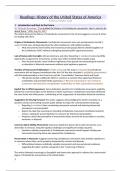Samenvatting
Samenvatting Readings History of the USA - Walter Licht
Geslaagd in eerste zit! (14/20) Samenvatting van de readings bij het vak History of the United States of America door professor Walter Licht (KUL) Bevat een uitgebreide samenvatting van alle readings, aangegeven welke teksten bij welk hoofdstuk uit het handboek/de lessen horen. Samenvatting ...
[Meer zien]



